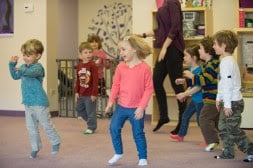Parenting Tip: Move to fast and slow beats! Why? Children perceive the world through their senses, and learning is most enjoyable and effective when multiple senses of a child's body are involved. For instance, when the children are clapping fast & slow tempi, they feel the movement of their hands, hear the sound their hands make, see their own (or others') hands move, and meet to make the sound. Multisensory learning environments – those that are rich with sensory experiences, allow freedom to explore, and have engaged parents – increase the potential for learning and are the 'three major factors…[that] lead to competency in adulthood.' – Carla Hannaford, Smart Moves. How? Sing along to I Love My Family! Can you sing the song without the video? Can you sing it faster, or slower? Get into a comfy chair, and enjoy the Video Playdate Field Trip! Find a favorite song from Kindermusik’s Friends & Family CD. Unpack some instruments (maybe a new Kindermusik instrument?). Can you play along to the song? Does your child prefer the beat, the faster micro-beat, or the slower macro-beat? Enjoy the e-book 'Flip Flap Sugar Snap' together. Have fun saying the ending rhymes together! Want to Learn More? On our blog: What is tempo? And why is it important? Kindermusik 7-Year Continuum: Kindermusik babies have help from their adults, who move baby’s body to fast & slow tempi. As toddlers, children begin to move their own bodies, in response to fast & slow sounds. Kindermusik preschoolers move to fast & slow, and begin to decide for themselves whether a specific song is ‘fast’ or ‘slow.’ Young Child students (ages 5 & 6) use their knowledge of tempo to help them play as an ensemble with their classmates, on glockenspiels, dulcimers, and recorders.
Warning: Illegal string offset 'url' in /hermes/bosnacweb04/bosnacweb04ci/b737/dot.kathysmusic/public_html/site/wp-content/themes/babykids/single.php on line 13



Leave a Reply